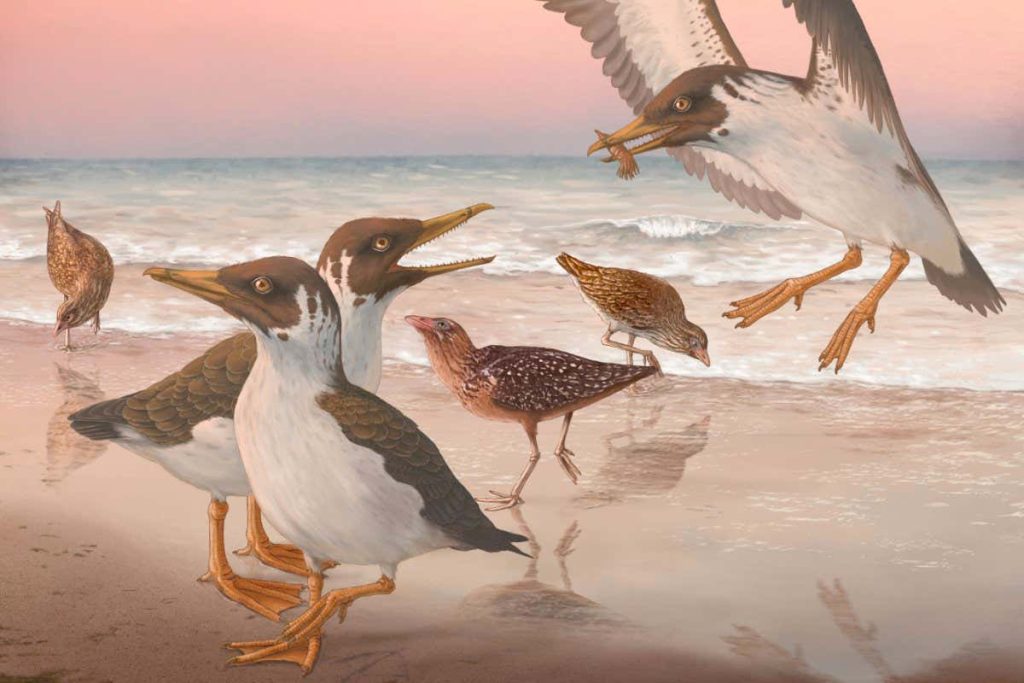Artist’s reconstruction of Janavis finalidens, a very large marine bird from the late Cretaceous. In the background are Asteriornis, another bird found in the same fossil deposit
Phillip Krzeminski
A 67-million-year-old bird skull has overturned an established theory about how modern birds evolved.
Unlike most modern birds, the flightless group that includes ostriches and emus can’t move their upper beaks – a feature that, for the past 155 years, has been considered primitive. The discovery of a jointed upper beak in a bird from the dinosaur age, however, suggests that the early ancestor of all modern birds may have had a jaw that looked more like that of a turkey than an ostrich, says Daniel Field at the University of Cambridge.
“The assumption that ostriches, rheas, emus and kiwis somehow retain features that are indicative of what the ancestor of modern birds might have been like – I think that’s actually just not right,” he says. “I always assumed that it was, but I don’t buy it anymore.”
Advertisement
In 1867, biologist Thomas Henry Huxley proposed that birds with fused upper beaks had maintained this trait from ancient ancestors, and that jointed upper beaks – which allow the top beak to move up and down independently of the head – evolved later. Approximately 99 per cent of modern birds have jointed upper beaks, which may have advantages for nest-building, grooming, food-gathering and defence, says Field.
About 20 years ago, researchers at the Natural History Museum of Maastricht, in the Netherlands, analysed a fossil partially encased in stone which had been found by a collector near Liège, Belgium. The team identified one of the protruding bones as a shoulder bone and believed that there were skull bones trapped inside the stone. They also found a tooth.
Then in 2018, Juan Benito, also at the University of Cambridge, borrowed the specimen from Maastricht. He was eager to study a fossil that might contain ancient bird skull bones, since they are so delicate that they rarely fossilise. To his disappointment, however, CT scanning revealed that the suspected skull bones were actually “just a bunch of vertebrae and ribs”, he says.
The rock containing the Janavis fossils
Dr Juan Benito and Dr Daniel Field, University of Cambridge
Two years later, Benito took another look at that so-called shoulder bone and thought it looked strange. He contacted Field and together they created 3D scans of that and another protruding bone that seemed to be mislabelled.
To their amazement, the two bone pieces matched up perfectly along their fragmented lines. Combined, they created a single bone that looked a lot like the jointed upper beak bone of most modern birds, called the pterygoid.
Comparisons of their scans with those of 34 other fossilised birds and dozens of modern birds confirmed the bone’s identity and suggested that, like modern turkeys and ducks – and unlike ostriches, emus and rheas – this ancient bird could lift its upper beak.
It would have been weighed about 1.5 kilograms – similar to a grey heron or turkey vulture, says Benito. The team named it Janavis finalidens, for Janus, the Roman god of beginnings and endings, and for the Latin words avis, finalis and dens, which mean bird, final and teeth.
Janavis finalidens was one of the last known toothed birds, which are suspected to have died out during the mass extinction of dinosaurs 66 million years ago.
The findings suggest that, surprisingly, ostriches and their relatives must have evolved a fused beak later, says Lawrence Witmer at Ohio University, who wasn’t involved in the study. “We always thought the palatal structure of ratites was primitive and dinosaur-like,” he says. “This new study is a remarkable example of how just a few key fossil remains – analysed with a keen eye – can overturn some longstanding and cherished notions.”
The discovery completes another puzzle as well. Last year, Chris Torres, now at Ohio University, and his colleagues pieced together nearly the entire skeleton of a million-year-old bird called an Ichthyornis, but they were missing one important bone in the beak. When Benito and Field scaled down their pterygoid to the relative size of the bird, the bone fit perfectly.
“We hypothesised that a… mobile palate must have been present in the ancestor of living birds, but that skull was missing the one bone that would have really closed the case,” says Torres. “Imagine my shock when, just over a year later, Juan, Dan and colleagues come along with that very bone from [a similar species] and it fits perfectly!”
Journal reference: Nature, DOI: 10.1038/s41586-022-05445-y
More on these topics:

